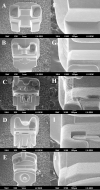Effect of bracket bevel design and oral environmental factors on frictional resistance
- PMID: 23621527
- PMCID: PMC8722825
- DOI: 10.2319/101612-808.1
Effect of bracket bevel design and oral environmental factors on frictional resistance
Abstract
Objective: To investigate the effects of bracket bevel design and oral environmental factors (saliva, temperature) on frictional resistance.
Materials and methods: Five types of brackets, namely a conventional bracket (Omni-arch), an active self-ligating bracket (Clippy), and three passive self-ligating brackets (Carriere, Damon, and Tenbrook T1) coupled with a 0.014-inch austenitic nickel-titanium archwire were tested. In the experimental model, which used a group of five identical brackets, the center bracket was displaced 3 mm to mimic the binding effects. The friction experiments were performed at three temperatures (20°C, 37°C, 55°C) in a dry or a wet (artificial saliva) state. Finally, the surfaces of the bracket slots were observed using scanning electron microscopy (SEM) before and after the friction tests.
Results: The sliding frictional force was significantly influenced by the bracket slot bevel and saliva whether in the active or passive configuration (P < .05). The frictional force significantly increased as the temperature increased in the active configuration (P < .01). Based on the SEM observations, a correlation was found among the level of frictional force, the bevel angle, and the depth of scratches on bracket bevels.
Conclusion: Frictional force can be reduced by increasing the bevel angle and by lowering the oral temperature, whereas the presence of saliva increases frictional resistance.
Figures







References
-
- Kusy RP, Whitley JQ. Friction between different wirebracket configurations and materials. Semin Orthod. 1997;3:166–177. - PubMed
-
- Whitley JQ, Kusy RP. Influence of archwire and bracket dimensions on sliding mechanism derivations and determinations of the critical contact angles for binding. Eur J Orthod. 1999;21:199–208. - PubMed
-
- Stolzenberg J. The Russell attachment and its improved advantages. Int J Orthod Dent Child. 1935;21:837–840.
-
- Wildman A. Round tablethe Edgelok bracket. J Clin Orthod. 1972;6:613–623. - PubMed
-
- Hanson G. The SPEED system a report on the development of a new edgewise appliance. Am J Orthod. 1980;78:243–265. - PubMed
Publication types
MeSH terms
Substances
LinkOut - more resources
Full Text Sources
Other Literature Sources

